现代语言学教程
现代语言学

现代语言学现代语言学语言学是对语言的系统研究,对于一个学习英语的人来说,应该懂一点语言学的知识,它可以在理论上对学习语言有指导作用,有助于更好的学习语言,下面介绍一点语言学知识。
I. Introduction1. What is LanguageLanguage is a system of arbitrary vocal symbols used for human communication2. What is Linguistics(语言学)Linguistics is the scientific study of language3.Some Basic Distinctions(区分) in Linguistics3.1 Speech and WritingOne general principle(原则)of linguistic analysis is the primacy of speech over writing. Writing gives language new scope(范畴)and uses that speech does not have3.2 Descriptive(描述性)or Prescriptive(说明性)A linguistic study is descriptive if it describes and analyses facts observed; it is prescriptive if it tries to lay down rules for "correct" behavior3.3 Synchronic(共时)and Diachronic(历时)StudiesThe description of a language at some point in time is a synchronic study and The description of a language as it changes through time is a diachronic study3.4 Langue(语言)and Parole(言语)This is a distinction made by the Swiss linguist F.De Saussure (索绪尔)early last century. Langue refers to the abstract linguistic system shared by all the members of a speech community and parole refers to the actualized(实际的) language, or realization of langue.3.5 Competence(能力)and Performance(行为)Competence is the ideal language user's knowledge of the rules of his language. Performance is the actual realization of this knowledge in utterances(发声)4.The Scope of LinguisticsGeneral linguistics is the study of language as a whole Phonetics(语音学)is the branch of linguistics which studies the characteristics of speech sounds and provides methods for their description, classification and transcription. Phonology(音韵学)is the branch of linguistics which studies the sound patterns of languagesMorphology(词法)is the branch of linguistics which studies the form of wordsSyntax(句法) is the branch of linguistics which studies the rules governing the combination of words into sentences Semantics(语义学)is the branch of linguistics which studies the meaning of language. Applied linguistics(应用语言学) is the study of the teaching of foreign and second languages Sociolinguistics is the study of the relationship between language and societyPsycholinguistics is the study of the relationship between language and the mindHistorical Linguistics(历史语言学) is the study of language changesAnthropological linguistics(人文语言学)uses the theories and methods of anthropology to study language variation and language use in relation to the cultural patterns and beliefs of manNeurolinguistics(神经语言学)studies the neurological basis of language development and use in human beings Mathematical linguistics(数学语言学)studies themathematical features of language, often employing models and concepts of mathematicsComputational linguistics(计算语言学)is an approach to linguistics in which mathematical techniques and concepts(概念) are applied, often with the aid of a computerII. Phonetics(语音学)1. scope of phoneticsSpeech sounds may be studied from different angles, thus we have at least three branches of phonetics:Articulatory phonetics(发音语音学)we may examine the way in which a speech sound is produced to discover which vocal organs are involved and how they coordinate(协调)in the processAuditory phonetics (听觉语音学)we may look into the impression a speaker makes on the hearer as mediated(调节)by the ear, the auditory nerve(神经) and the brainAcoustic phonetics (声学语音学)we study the physical properties of speech sounds, as transmitted(传送)between mouth and ear2. The vocal organsThe vocal organs may be viewed as consisting of three parts, the initiator of the air-stream,(气流发生器官)the producer of voice(声音发生器官) and the resonating cavities.(声音共振器官)3. Consonants(辅音)Places of articulation(发音部位): bilabial,(双唇)Labiodentals,(唇齿)dental,(齿)alveolar,(齿龈)retroflex,(卷舌)palate-alveolar,(上齿龈)palatal,(上颚)velar,(软腭)uvular,(小舌)glottal(声门)Manners of articulation: plosive,(暴破)nasal,(鼻音)trill,(颤音)lateral,(边音)fricative,(摩擦)approximant,(近似音)affricate(破擦)4. Vowels (元音)The classification of vowels: the height oftongue raising (high, mid, low), the position of the highest part of the tongue(front, central, back), and the degree of lip rounding(rounded, unrounded)III. Phonology(音韵学)1. phonemes(音素):a distinctive(有区别的) sound in a language2. Allophones(音位变体):The nondistinctive sounds are members of the same phoneme3. Minimal pairs(最小对立体):word forms which differ from each other only by one sound4. Free variation (自由变异):If two sounds occurring in the same environment(环境), they does not produce a different word form, but merely a different pronunciation of the same word5. Complementary distribution(补充分类):Not all the speech sounds occur in the same environment. When two sounds never occur in the same environment6.Suprasegmental phonology(超音段音位):the study of phonological properties (性质)of units lager than the segment-phoneme. They are syllable(音节),stress,(重音)word stress, sentence stress. Pitch (音调)and intonation(语调)IV. Morphology(词法)1. inflection(构形法):the grammatical relationships through the addition of inflectional affixes.(屈折词缀)2. Word-formation(构词):the processes(过程) of word variations signaling lexical relationships.(表明词法关系)They are compound(合成)and derivation (派生)3. Morpheme(词素):the smallest unit in terms of relationship between expression and content4. Allomorph(同质异象变体):some morphemes haveconsiderable variation, for instance, alternate shapes or phonetic forms5. Types of morphemes: They are roots,(词根) affix(词缀)and stem(词干)6. Lexicon(语言词汇):in its most general sense, is synonymous with vocabulary7. Closed-class words(封闭性) and open-class words(开放性):the former whose membership is fixed or limited and the latter whose membership is in principle(实际上) indefinite or unlimited8. Word class(词性):It displays a wider range of more precisely defined classes9. Lexeme(词位):the smallest unit in the meaning system of a language that can be distinguished from other smaller units10. Idiom(习语,成语):Most phrasal lexemes are idioms. It is especially true for a sequence of words(词序)which is semantically(语义上)and often syntactically(句法上)restricted.(限制)11. Collocation(搭配): the habitual(习惯的)co-occurrences (同时出现)of individual lexical items V. Syntax (句法)1. Positional relation or word order(词序):the sequential (顺序) arrangement of words in a language2. Construction or constituent (句子结构):the overall process of internal (内部)organization of a grammatical unit3. Syntactic function(句法功能): the relationship betweena linguistic form and other parts of the linguistic pattern in which it is used. The names of functions are expressed in terms of subjects, objects, predicates, modifiers,(修饰语) complements (补语), etc4. Category(范畴):It refers to classes and functions in itsnarrow sense, e.g. noun, verb, subject, predicate, noun phrase, verb phrase, etc. The categories of the noun include number, gender, case and countability5. Phrase: a single element of structure containing more than one word, and lacking the subject-predicate structure typical of clause6. Clause: a group of words with its own subject and predicate, if it is included in a larger sentence7. Sentence: It is the minimum part of language that expresses a complete thoughtVI. Semantics1. Conceptualism or mentalism (概念主义):Following F. De Saussure(索学尔)'s "sign" theory, the linguistic sign is said to consist of a signifier (所指)and signified(被指), i.e., a sound image and a concept, liked by a psychological(心理的)"associative" bond.(相关联系)2. Mechanism(机械主义):Some linguists, Bloomfield,(布鲁费尔德) for example, turned to science to counter(反)-act the precious theories and this leads to what call the mechanistic approach(方法). The nature of this theory has nothing to do with the scientific study of mental phenomena.(智力现象)3. Contextualism (语境主义):It is based on the presumption(假定)that one can derive meaning from or reduce it to observable context4. Behaviorism (行为主义):Behaviourists attempt to define (定义)the meaning of a language form as "the situation (情景) in which the speaker utters(说话) it and the response (反应) it calls forth in the hearer."5. functionalism (功能主义):Functionalists as represented (代表)by the Prague school(布拉格学派) linguists and neo-Firthian (新弗斯)linguists, approach the problem from an entirely new orientation(方法). They argue(争辩)that meaning could only be interpreted(解释)from its use or function in social life6. Sense relationships: While reference deals with the relationship between the linguistic elements, words, sentences, etc.,and the non-linguistic world of experience, sense relates to the complex system of relationships that hold between the linguistic elements themselves. They include synonymy(同义词),antonymy(反义词),hyponymy(下层次)Polysemy(一词多义)and Homonymy (同音异义词)7. Semantic analysis: It includes1)componential(成分)analysis which defines the meaning of a lexical element in terms of semantic components.(意义成分)2) predication (表述)analysis in which the meaning of a sentence is not merely the sum of the meanings of the words which compose it.3) relational components in which the semantic analysis of some words presents a complicated picture, because they show relations between two and perhaps more terms.VII. Language Variation (语言变化)1. Lexical change(词汇的变化):changes in lexis2. Invention: (新造词)new entities3. Compounding:(合成词)New words are sometimes constructed by combining two old words4. Blending: (混合词):It is a relatively complex form of compounding, in which two roots are blended by joining the initial part of the first root and the final part of the second root, or by joining the initial parts of the two roots5. Abbreviation or clipping:(缩写)A new word is created by cutting the final part or cutting the initial part6. acronym:(取首字母的缩写词)It is made up from the first letters of the name of an organization, which has a heavily modified (修饰) headword7. Metanalysis:(再分化)It refers to a process through whicha division is made where there were note before8. Back-formation:(逆构词) It refers to an abnormal(非正常) type of word-formation where a shorter word is derived by deleting(去掉)an imagined affix from a longer form already present in the language.9. Analogical creation:(类比造词)It can account for(说明)the co-existence of two forms, regular and irregular, in the conjugation(结合) of some English verbs10. Borrowing(借用):English in its development has managed to widen her vocabulary by borrowing words from other languages11. Phonological change(音变):It is related to language variation in the phonological system of language. It includes loss,(省音)addition,(加音)assimilation,(同化)dissimilation.(异化)12. Grammatical change: Changes in both morphology(词法) and syntax(句法) are listed under this heading13. Semantic change:(语义变化)It includes broadening,(语义扩大) narrowing,(语义缩小) meaning shift,(意义转化)class shift(词性转换) and folk etymology.(词源变化)14. Orthographic change :(正字法)Changes can also be found at the graphetic level。
现代语言学教程》(ACOURSEINMODERNLINGUISTICS-西华大学

第三节 语言系统是人类特有的
一、语言能力 二、语言是其他动物和人类之间无法逾越的鸿沟 三、人类语言和所谓动物“语言”的根本区别
语言学概论
第一节 语言符号的性质和特点
语言学概论
第一节 语言符号的性质和特点
一、符号概述
古烽火台
符号是代表某种事物或表达某种意义的标记或记号。 语言符号中的形式和意义的结合完全由社会“约定俗
语言学概论
第二节 语言符号的系统性
实例8:英语语素(词缀)的聚合
表程度和形状的前缀 : archarch-enemy,arch-bishop,arch-liar,arch-fascist supersuperman,super-market,super-natural,super-digestible outoutgrow,outlive,outrun,out-weigh,out-wit,out-do sursurchrge,surtax subsubhuman,subnormal,subconscious overoverdo,overdimplify,overdressed,overconfident,oversensitive underundercook,underwork.,underhanded,underprivileged 语言学概论
b d g
p t k
m n ng
双唇音的聚合
舌尖中音的聚合 舌根音的聚合
参 见 《 汉 语 拼 音 方 案 》 。
鼻音的聚合 送气塞音的聚合 不送气塞音的聚合
满 足 语 音 搭 配 的 规 则 , 具 体
语言学概论
第二节 语言符号的系统性来自实例3:语音(汉语辅音)的聚合
z c s zh ch sh j q x
现代语言学教程霍凯特读书笔记
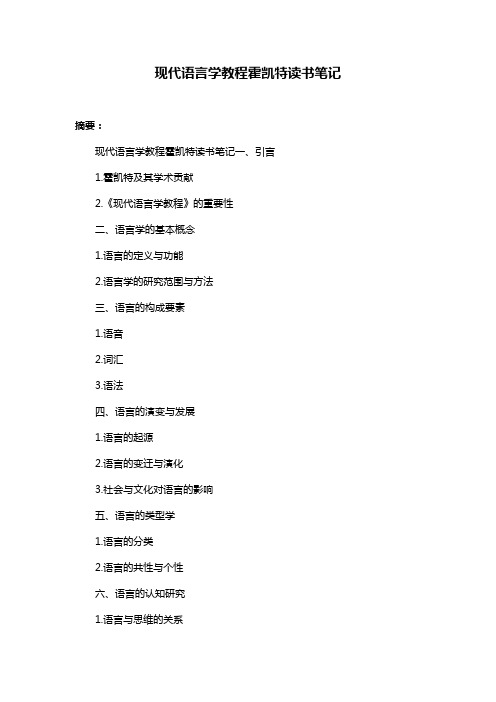
现代语言学教程霍凯特读书笔记摘要:现代语言学教程霍凯特读书笔记一、引言1.霍凯特及其学术贡献2.《现代语言学教程》的重要性二、语言学的基本概念1.语言的定义与功能2.语言学的研究范围与方法三、语言的构成要素1.语音2.词汇3.语法四、语言的演变与发展1.语言的起源2.语言的变迁与演化3.社会与文化对语言的影响五、语言的类型学1.语言的分类2.语言的共性与个性六、语言的认知研究1.语言与思维的关系2.语言习得与认知发展七、语言的应用领域1.语言教学与学习2.语言技术应用3.语言与跨文化交流八、结语1.《现代语言学教程》的价值与启示2.对未来语言学研究的展望正文:现代语言学教程霍凯特读书笔记霍凯特(H.Jackson)的《现代语言学教程》是一部系统阐述现代语言学基本理论、方法与应用的著作。
该书以严谨的学术态度、全面的视角和丰富的实例,为读者呈现了语言学的全貌。
以下是对该书内容的概括与解读。
一、引言霍凯特是20世纪下半叶英国著名的语言学家,他的学术贡献主要集中在历史语言学、语音学、语义学等领域。
他的《现代语言学教程》是一部经典的语言学教材,对我国现代语言学的发展产生了深远影响。
二、语言学的基本概念语言是人类的交际工具,是人类社会特有的现象。
语言学是研究语言的科学,其研究范围包括语音、词汇、语法等方面。
语言学的研究方法主要有历史比较法、实验法、观察法等。
三、语言的构成要素语音是语言的基本构成要素,包括音素、音位、音节等。
词汇是语言的基本单位,包括词汇意义、语法意义和联想意义。
语法是语言的结构规则,包括句法结构和语义结构。
四、语言的演变与发展语言起源于人类的交际需要,经历了从原始语言到现代语言的发展过程。
语言的变迁与演化受到社会、文化、历史等多种因素的影响。
五、语言的类型学语言可以根据不同的标准进行分类,如按语系、语族、语支等。
各种语言在语音、词汇、语法等方面既有共性,又有个性。
六、语言的认知研究语言与思维密切相关,语言的发展与认知发展相互作用。
现代语言学

A Course of Modern LinguisticsChapter 1 Language and Linguistics1. langue and parole 语言和言语When we are looking at language, we may come across two very important terms—langue and parole which were introduced into linguistics by Saussure, a Swiss linguist. Langue is defined as the language system that speakers of the language conform to in their verbal communication. Parole refers to the concrete speech that individual speakers produce in their verbal communication.2. What is language?Language in ge neral is ―a system of symbols designed for the purpose of communicating thoughts or feelings, through the use of voice sounds or written symbols in organized combinations and patterns.‖3. Design features of language 语言的识别性特征In this course, we’re going to discuss seven design features: arbitrariness, non-arbitrariness, genetic-cultural transmission, duality, discreteness, productivity and systematicity.(1) Arbitrariness vs. non-arbitrariness 语言的任意性和非任意性Arbitrariness, the immense freedom offered by broad arbitrariness of language, is subject to the constraints imposed by non-arbitrariness, the necessary compliance with grammar, idiomatic usage and social norms.(2) Transmission of language 语言的传递性Genetic transmission (遗传传递性) was put forward by Chomsky. According to him, language ability was genetically determined.Cultural transmission (文化传递性) was put forward by Hockett. According to him, it is the cultural environment that plays a crucial role in language acquisition.(3) Duality of language 语言的二重性Language has two levels. The higher level is concerned with how meaningful units are combined into a larger construction to convey meaning. At the lower level, language consists of a sequence of segments without any meaning in themselves. Duality of language contributes to the flexibility and versatility of language by facilitating language transmission.(4) Discreteness of language 语言的离散性Discreteness of language refers to the property of language that the symbols at the lower level all have definable boundaries, allowing variations in form but no gradation or continuity in identity.(5) Productivity of language 语言的创造性Productivity of language refers to the property of language which allows or enables the speaker to construct or interpret a string of linguistic forms that has never been produced or encountered, provided that it complies with the rules of the language.(6) Systematicity of language 语言的系统性3. Linguistics 语言学Linguistics is the science of language.Chapter 2 PhoneticsPhonetics (语音学) is the science that studies sounds, especially speech sounds, providingmethods for the description, classification and transcription of the sounds used in speech.1.Three branches of phonetics 语音学的三个分支(1) articulatory phonetics 发音语音学(2) acoustic phonetics 声学语音学(3) auditory phonetics 听觉语音学2. V ocal organs (lungs, larynx, pharynx, mouth and nose) 发音器官the three elements necessary for speech sounds production: the vibration of a physical body or the turbulent airflow, the acoustic noise is resonated and magnified by the bodies of air in the vocal tract; the variations in the shapes of the air-containers in the vocal tract determine the differing qualities of the speech soundsfour functions of the larynx (vocal cords) in speech: generating vocal vibrations; producing a glottal stop; producing a glottal fricative; keeping vocal folds apart to let the air pass3. Consonants 辅音Consonants are sounds made by a closure or narrowing somewhere (i.e. place of articulation 发音部位) in the vocal tract so that airflow is either completely blocked, or so restricted that audible friction is produced (i.e. manner of articulation发音方式) and the sounds may or may not involve the vibration of the vocal folds (i.e. voicing声带是否振动).A distinctive feature区别性特征4. V owels 元音V owels are sounds articulated without a complete closure in the mouth or a degree of narrowing which would produce audible friction and the air escapes evenly over the centre of the tongue.distinctive features: the position of the lips, the two-dimensional tongue position.Chapter 3 PhonologyPhonology 音系学: the science that studies how speech sounds are used in language to convey meanings1. Phoneme, allophone, and phone 音位,音位变体和音素Phoneme is a group of sounds that are phonetically similar and show certain characteristic patterns of distribution in the language under consideration.Allophone refers to a phonological variation of a phoneme.A phone is a sound that is actually produced in communication; it is of physical identity and is concrete in nature.The relation between phoneme, allophone and phone is a matter of realization. A phoneme is realized by its allophones; an allophone is realized in turn by a phone.2. Supra-segmental phonology 超切分音系学Supra-segmental phonology is concerned with the phonological features that extend more one segment.(1) pitch & tone 音高和声调(2) loudness & stress 响度和重音(3) tempo & rhythm 速度和节奏(4) pause & juncture 停顿和音渡Chapter 4 MorphologyMorphology 形态学: the study of the structure and the formation of words in language1. Inflectional & derivational morphology屈折形态学和派生形态学inflection: the formal changes of a word or part of a word in relation to its differing grammatical meaningsderivation: the formation of a new word by adding an element such as an affix2. Morpheme, morph & allomorph 语素、语素形态和语素变体Morpheme is a minimal unit which is formally composed of meaningless linguistic symbols at the lower level of the language and which is used in a variety of contexts with a constant meaning.Morph is a phonological form representing the relevant morpheme in speech or in writing. Morpheme is abstract in nature and is realized through its morph.Allomorph is a morphological variant of morpheme (i.e. one member of the group of morphs that realize the morpheme in speaking or writing).3. Free morpheme & bound morpheme自由语素和粘着语素Free morpheme is a morpheme that can stand alone as a word. Bound morpheme is a morpheme that cannot stand alone as a word.4. Inflectional morpheme & derivational morpheme 屈折语素和派生语素5. Lexical morpheme & grammatical morpheme 词汇语素和语法语素Chapter 5 SyntaxSyntax 句法学studies the ways words are combined to form sentences in a language.1. Traditional bottom-up approach 自下而上的传统方法是从词到句进行研究2. Constituency top-down approach 自上而下的成分分析法是从句到词,通常以tree diagram(树形图)的方式研究句子3. Constituent Structure Rules vs Lexical Insertion Rules 成分结构规则和语汇插入规则three constituent structures:;;lexical insertion rule: one that governs selecting from the lexicon a lexical item and inserting it into a terminal node of a constituent structure as its daughter node4. Selection restrictions 选择限制Syntactical selection restriction 句法选择限制;Semantic selection restriction 语义选择限制5. Transformational generative grammarproposed by Noam Chomsky consists of three components: the syntactic component, the phonological component and the semantic component.The syntactic component in Chomsky’s model comprises of a set phrase structure rules and a set of transformational rules. Our discussion is focused on three types of transformations: passive transformation被动转换[NP1–Aux–V–NP2 –Aux+Pass–V–by+NP1: (1) The boy ate the cake. (2)The cake was eaten by the boy.]interrogative transformation 疑问转换[NP–Aux1–X –NP–X: (1)The boy has eaten the cake. (2) Has the boy eaten thecake?]negative transformation 否定转换[X–Aux1––Aux1+Neg–Y: (1) The boy will eat the cake. (2) The boy will not eat the cake. / NP –Tense – MV –– NP – MV –X: (3) The boy eats the cake. (4) The boy does not eat the cake.]Chapter 6 SemanticsSemantics语义学is the science of meaning.1. A very old view about meaning has been known as naming theory命名论.the conceptual view: the meaning of a word is the concept that is permanently associated with the word in our mindsA prototype is an original type, form or instance that serves as model on which later stages are based or judged.2. Sense & Reference 意义和所指sense: the meaning that relates linguistic forms with what is in the non-linguistic world;reference: the meaning that lies in the relation or contrasts among linguistic forms themselves Relation between sense and reference(1) Forms different in sense may have the same reference. (e.g. my new car; the car that I have just bought; This is the car.)(2) Forms identical in sense may have different references. (e.g. This is my car. This is my car.)(3) Forms that have a sense but have no reference. (e.g. The present King of France is bald.)3. Lexical meaning 词汇意义Lexical meaning refers to the sense in which a word is used.(1) Synonymy 同义关系Synonymy refers to the sameness in meaning between two or more words.–用在不同地域方言中的同义词(fall–autumn)–语体不同的同义词(ain't–’m not)–应用范围不同的同义词(employer–boss)–用于不同搭配的同义词(strong coffee–powerful machine)(2) Polysemy 多义关系Polysemy refers to the linguistic phenomenon that a word may be used in a number of different senses or is said to have a range of different meanings. (e.g. base)(3) Homonymy 同音/同形异义关系Homonymy refers to the sense relation that two or more words have the same form, both orthographic and phonologic, but differ in meaning (e.g. bear). (4) Antonymy反义关系Antonymy refers to the oppositeness of meaning.- gradable可分等级的反义词(more/ less)- complementary互补性反义词(man/ woman)- relationally opposite关系反义词(husband/wife)(5) Hyponymy 上下义关系Hyponymy refers to the sense relation between a more general word and a more specific word. (e.g. flower-rose)Chapter 7 Pragmatics, discourse analysis and text linguisticsPragmatics 语用学is the study of the meaning which is not included in semantics andwhose interpretation is dependent on its social contexts.Discourse analysis话语分析is the study of speech, focusing specially on the relation between discourse and its contexts.Text linguistics篇章语言学is part of discourse analysis, concerning mostly the grammatical or textual features of written language.1. Cohesion in texts of discourse衔接Cohesion refers to the linguistic property of units larger than the morpheme to bind together in construction, or the relations of meaning that exist within the text and that define it as a text. (1) Grammatical cohesionReference指代means indicating or referring something for interpretation. It may be analyzed into two categories: exophoric and endophoric.Substitution替代refers to the replacement of one item by another in the text and is concerned with the way substitutions realize the grammatical cohesion in the text.Ellipsis refers to the omission of an item in an utterance or in a text.Conjunction refers to the linguistic expressions that combine two elements in construction. (2) Lexical cohesion 语义衔接reiteration and collocation2. Cohesion vs. coherence 衔接和连贯Coherence refers to the natural, reasonable or logical connection in meaning among the componential parts of a text.The presence of the formal markers of cohesive relation does not necessarily mean the presence of coherence, nor does the absence of the formal marker entail the absence of coherence in the text.3. Implicatures 蕴涵Implicature refers to what a speaker implies, suggests, or means, as distinct from what is literally said. Implicatures may be divided into two types: conventional (what the speaker implies is conventionally associated with the expressions used by the speaker) and conversational (what the speaker implies has to be inferred from the particular context of the conversation).Conversational implicatures presume that the participants of the conversation follow a cooperative principle defined by Grice. The cooperative principle is embodied in four maxims. An implicature occurs when the speaker purposely flouts some of the maxims in conversation.the maxim of quality质量准则[the speaker is required to speak sincerely (e.g. A: What will you do if you fail the exam? B: I’ll eat my hat.)]the maxim of quantity数量准则[the speaker is required to provide as much information, not too much and not too little (e.g. A: I suffered a lot in the war. I heard that you suffered a heavy loss in the war, too. Tell me what you lost. B: War is war, you know.)]the maxim of relevance相关准则[the speaker is required to speak to the point (e.g. A: Will John come to our party? B: He is busy painting his house, you know.)]the maxim of manner方式准则[the speaker is required to speak clearly, briefly and to present events in a correct order (e.g. A: You’re eating the apple! Did you wash it? B: I eat it and then wash it, you know.)]4. Speech acts theory 语言行为论the locutionary act: the act of saying something meaningful in a particular language (e.g. Will you open the door for me)the illocutionary act: a conventionally associated act that the speaker simultaneous undertakes when performing the locutionary act (i.e. saying something meaningful) the perlocutionary act: an act performed as the consequence of the related locutionary and illocutionary actsChapter 8 SociolinguisticsSociolinguistics is the study of the various aspects of the relation between language on the one hand and speakers and society on the other.1. Dialect 方言regional dialects (or geographical dialects) & social dialects 地域方言和社会方言Regional dialect refers to a variety of language that is commonly found in a certain geographic region, and that may inform on the speaker’s geographic background. Social dialect refers to a variety of language that is commonly found among a certain group of people who have in common some social, cultural or economic features, and that may inform on the speaker’s social positions accordingly.2. Diglossia双语体Diglossia refers to a situation where two very different varieties of a language co-occur throughout a speech community, each with a distinct range of social function.3. Language planning(1) Lingua franca 族际通用语Lingua franca is now used to refer to a variety of language that is nobody’s native language and that is used to enable routine communication to take place between groups of people who speak different native languages.(2) Pidgins and Creoles 洋泾滨和克里奥尔语Pidgin refers to a kind of lingua franca which is also known as ―marginal language‖. It has a reduced grammatical structure, lexicon and stylistic range and has no native speakers. The formation of a pidgin usually involves two or more speech communities and requires considerable motivation on the part of the speaker.Creole refers to the pidgin which has developed from a mixture of languages and expanded in its vocabulary, grammar and stylistic range, which has acquired its own native speakers and assumed an equal or similar status of any human natural language.4. Language and society and cultureApart from establishing or maintaining social relationships between the speaker and the hearer or conveying information about the speaker, language may also reflect or reveal the social and cultural environment in which it is spoken.5. Language changeChapter 9 PsycholinguisticsPsycholinguistics is the study of the relation between language and mind, especially language acquisition and learning, and language comprehension and production.1. Language acquisition and language learningLanguage acquisition refers to the process that children use in acquiring their first language or languages before the critical age around 13.Language learning refers to the process that language learners undergo in their language learning through formal language education.(1) Different theories about language acquisition:– Imitation theory– Theory of reinforcement– Theory of innate capacity(2) Stages of language acquisition 习得语言的几个阶段-- The naming and holophrastic stage 单语词阶段-- The telegraphic stage 电报式语言阶段(双语词阶段)-- The morphemic-transformational stage 词素与转换阶段(更长更复杂的句子)(3) Language acquisition and errorsOver-generalization (over-extension)过度推广化refers to assigning new objects to a wordOver-regularization (over-simplification)过度规则化refers to applying a regulation or a rule to a form which is(4) Transfer errors 转移错误Transfer errors found in L2 learning refer to the errors resulting from improper applications of L1 rules to L2).2. Language and thoughtLanguage as the instrument of thinking3. Language comprehensionfour different levels: perceptual level 感知层次, lexical level 词汇层次, sentential level 句子层次, discourse level话语层次4. Language productionConstruction 构建; Transformation or articulation 转换或发音; Execution执行About the Final Examination (Part I)Decide whether each statement is true (T) or false (F). (15 points)e.g. Linguistics studies one specific language. (F)综合练习一TLinguistics studies not any particular language, but languages in general.F Phonetics deals with how sounds are put together and used to convey meaning.FModern linguistics is mostly descriptive, but sometimes prescriptive.TThe classification of English consonants involves both manner of articulation and place of articulation.FSometimes bound morphemes can be used by themselves.FLanguage is only linearly-structured.TMeaning is central to the study of communication.TPragmatics is related to and also different from semantics.TSociolinguistics studies language in social contexts.FThere is a three-word sentence stage in first language acquisition.综合练习二F A scientific study of language is based on whatthe linguist thinks.FMorphology and syntax study the same aspect of language.F A synchronic study of language is a historical study.TIntonation plays an important role in the conveyance of meaning in almost every language, especially in a language like English.T A morpheme is the basic unit in the study of morphology.T A simple sentence consists of a single clause which contains a subject and a predicate and stands alone as its own sentence.TComplete synonyms are rare in language.T A locutionary act is the act of conveying literal meaning by means of syntax, lexicon, and phonology.FLinguistic performance is essentially a social phenomenon but not a context-dependent behavior.FThe age at which children pass through the one-word stage is the same from child to child.综合练习三TGeneral linguistics studies the basic concepts, theories, descriptions, models and methods applicable in any linguistic study.TThe study of meaning in language is known as semantics.FLanguage is entirely arbitrary.FEnglish is a typical tone language.FCompounding is the addition of affixes to stems to form new words.TGrammatical sentences are formed following a set of syntactic rules.TThe naming theory of meaning was proposed by the ancient Greek scholar Plato.FThe notion of context is not important to the pragmatic study of language.T A Creole language is originally a pidgin that has become established as a native language in some speech community.FSome languages are superior to other languages.综合练习四FSociolinguistics has nothing to do with language or society.TModern linguistics is different from traditional grammar.FOnly a few of the languages in the world today are both spoken and written.FDistinctive features are the same to any language.TMorphology studies the internal structure of words and the rules why words are formed.FIn English and many other languages, the subject usually follows the verb and the direct object usually precedes the verb.THomophones are words which are identical in sound.FAll utterances take the form of sentences.TFrom a sociolinguistic perspective, a speech variety is no more than a dialectal variety of a language.TPsycholinguistics is viewed as the intersection of psychology and linguistics.About the Final Examination (Part II)Decide which one of the four choices best completes the statement. (15 points)e.g. F.de Saussure is a(n) ___ linguist.A. AmericanB. BritishC. SwissD. Russian综合练习一1. ______ deals with how language is acquired, understood and produced.A. SociolinguisticsB. PsycholinguisiticsC. PragmaticsD. Morphology2. The pharynx refers to the space of cavity between the larynx and the end of ______. A. tongue B. hard palate C. soft palate D. vocal cords3. The vowel [u:] in [fu:d] (food) is ______ vowel.A. backB. frontC. unroundedD. central4. Two words that are ―opposite‖ in meaning are called ______.A. synonymsB. homonymsC. antonymsD. homophones5. The morpheme ―vision‖ in the common word ―television‖ is a(n) _______.A. bound morphemeB. bound formC. inflectional morphemeD. free morpheme6. Modern English has a much weaker case marking system. Its sentences have to follow a basic order of ______. A. SVO B. VOS C. SOV D. OSV7. ______ is the study of how speakers of a language use sentences to effect successful communication.A. SemanticsB. PragmaticsC. SociolinguisticsD. Psycholinguistics8. Morphemes that represent ―tense‖, ―number‖, ―gender‖, ―case‖ and so forth are called ______ morphemes.A. inflectionalB. boundC. freeD. derivational9. Application of the transformational rules yields ______ structure.A. phrase D. deep C. prelexical D. surface10. ______ are language varieties appropriate for use in particular speech situations. A. SlangB. Address termsC. RegistersD. Education varieties综合练习二1. ______ is formed by a narrowing of the air passage at some point so that the air in escaping makes a kind of hissing sound.A. A plosiveB. A fricativeC. An affricateD. Laetrile2. The vowel [i:] in [fi:d] is a ______ vowel.A. close front unroundedB. close back unroundedC. open front roundedD. close back rounded3. ______ covers the study of language use in relation to context, and in particular the study of linguistic communication.A. SematicsB. PragmaticsC. SociolinguisticsD. Stylistics4. The fact that ability to speak a language is transmitted from generation to generation by a process of learning, and not genetically is usually referred to as ______.A. performanceB. language acquisitionC. cultural transmissionD. competence5. Of all the speech organs, the _____ is / are the most flexible.A. mouthB. lipsC. tongueD. vocal cords6. ______ is defined as any regionally or socially definable human group identified by shared linguistic system.A. A speech communityB. A raceC. A societyD. A country7. ______ made the distinction between langue and parole.A. ChormskyB. SaussureC. SapirD. Hall8. Morphemes such as ―-er‖, ―-en‖, ―dis-‖ and so forth are called ______ morphemes.A. inflectionalB. derivationalC. freeD. bound9. Transformational rules do not change the basic ______ of sentences.A. formB. structureC. sound patternD. meaning10. ______ are written identically but sound differently.A. HomographsB. HomohphonesC. HomonymsD. Synonyms综合练习三1. ______ variation of language is the most discernible and definable in speech variation.A. RegionalB. SocialC. StylisticD. Idiolectal2. The sound [s] and [z] are the results of air escaping under frication between tongue and ______ before passing through the teeth.A. hard palateB. uvulaC. alveolar ridgeD. soft palate3. ______ studies how sounds are put together to convey meaning in communication.A. PhonologyB. MorphologyC. LexicologyD. Phonetics4. Modern linguistics, i.e., linguistic study carried out in this century is mostly ______, that is, it describes and analyses language.A. descriptiveB. prescriptiveC. synchronicD. diachronic5. The most distinguishable linguistic feature of a regional dialect is its ______.A. syntaxB. vocabularyC. grammarD. accent6. The study of linguistic meaning of words, phrases, and sentences is called ______.A. phonologyB. morphologyC. syntaxD. semantics7. ______ refers to a marginal language of few lexical items and straight forward grammatical rules, used as a medium of communication.A. Lingua francaB. CreoleC. PidginD. Standard language8. ______ deals with language application to other fields, particularly education.A. Linguistic geographyB. Applied linguisticsC. SociolinguisticsD. Comparative linguistics9. The most recognizable differences between American English and British English are in ______ and vocabulary.A. structureB. grammarC. usageD. pronunciation10. A phoneme is a group of similar sounds called _____.A. minimal pairsB. allophonesC. phonesD. allomorphs综合练习四1. V owels that are produced between the positions for a front and back vowel are called ______ vowels. A. open B. close C. front D. central2. A sound pronounced with the vocal cord vibrating is said to be a ______ sound. A. resonantB. voicelessC. voicingD. consonant3. ______ is defined as a conscious process of accumulating knowledge of a second language usually obtained in school settings.A. CompetenceB. PerformanceC. LearningD. Acquisition4. The goal of ______ is to explore the nature of language variation and language use among a variety of speech communities and different social situations. A. psycholinguistics B. sociolinguisticsC. historical linguisticsD. general linguistics5. Pitch variation is known as ______ when its patterns are imposed on sentences.A. intonationB. toneC. pronunciationD. voice6. The study of language as a whole is often called ______ linguistics.A. particularB. generalC. ordinaryD. generative7. A scientific study of language is based on the ______ investigation of language data. A. symbolic B. systemic C. systematic D. system8. There are rules that govern which affix can be adde3de to what type of ______ to form a new word. A. stem B. affix C. root D. word9. The syntactic rules of any language are ______ in number.A. largeB. smallC. finiteD. infinite10. Words that are opposite in meaning are ______.A. synonymsB. hyponymsC. homophonesD. antonymsAbout the Final Examination (Part III)Dissect the following words into morphemes. (10 points)some words from the on-line exercisesEg. Refreshment (re-fresh-ment)About the Final Examination (Part IV)Define each of the following terms. (30 points)the terms in the on-line exercises综合练习一1. tone-unit: the basic unit of intonation in a language.2. consonant: the sound in the production of which there is an obstruction of the air-stream at some point of the vocal tract. Consonants are characterized in pronunciation by constriction of the air-stream in the vocal tract.3. free morpheme: independent units of meaning and can be used freely all by themselves.4. acoustic phonetics: Acoustics phonetics studies the vibrations of the air molecules. It studies the physical properties of speech sounds, as transmitted between mouth and ear.5. reference: Reference means that a linguistic from refers to in a real, physical world; it deals with the relationship between the linguistic element and non-linguistic world of experience.6. synonymy: the sameness or close similarity of meaning.7. discourse: a continuous stretch of language larger than a sentence, a unit of linguistic organization , and a recognizable communicative event.8. illocutionary act: the act of expressing t he speaker’s intention; it is the act performed in saying something.9. utterance: Utterance is the bit of spoken or written language that is produced and sent to the receiver in a specific context.10. language acquisition: a general term used to refer t o the development of a person’s first, second, or foreign language.综合练习二1. phonology: The study of sound system –the inventory of distinctive sounds that occur in a language and the patterns into which they fall.。
现代语言学教程霍凯特读书笔记

现代语言学教程霍凯特读书笔记摘要:1.霍凯特的现代语言学教程概述2.语言学的基本概念与理论3.霍凯特的现代语言学教程的贡献与影响4.读书笔记的价值与意义正文:霍凯特的现代语言学教程是一本非常具有代表性的语言学教材,它为语言学领域的学者和研究者提供了许多有价值的理论和观点。
本文将从以下几个方面探讨霍凯特的现代语言学教程以及我的读书笔记。
首先,让我们来了解一下霍凯特的现代语言学教程的概述。
这本书主要分为三个部分,第一部分是语言学的基本概念与理论,包括语言的定义、语言的功能、语言的结构等方面;第二部分是语言学的研究方法,包括实验方法、观察方法、比较方法等;第三部分是语言学的应用,包括语言教学、语言翻译、语言规划等方面。
这本书的结构清晰,内容丰富,是一本非常优秀的语言学教材。
接下来,我们来讨论一下语言学的基本概念与理论。
霍凯特在这本书中对语言学的基本概念与理论进行了详细的介绍和阐述。
他认为,语言是人类最重要的交际工具,是人类社会发展的重要标志。
语言具有语音、语法、语义、语用等结构,这些结构相互关联,共同构成了语言的完整系统。
此外,霍凯特还介绍了语言的演变、语言的习得、语言的变异等重要概念,这些概念对于我们理解语言的本质和规律具有重要的意义。
再来看一下霍凯特的现代语言学教程的贡献与影响。
这本书对于语言学的发展具有重要的贡献,它不仅提供了许多有价值的理论和观点,而且也为语言学的研究提供了新的思路和方法。
此外,这本书对于语言学的教学和应用也产生了深远的影响,它成为了许多语言学课程的主要教材,也为语言工作者提供了重要的参考资料。
最后,我们来谈一下读书笔记的价值与意义。
读书笔记是一种非常重要的学习方法,它可以帮助我们整理思路,加深理解,提高记忆。
读书笔记也可以帮助我们发现问题,思考问题,解决问题。
因此,读书笔记对于我们的学习和研究具有重要的价值和意义。
总的来说,霍凯特的现代语言学教程是一本非常优秀的语言学教材,它为我们提供了许多有价值的理论和观点。
结构主义《现代语言学教程》
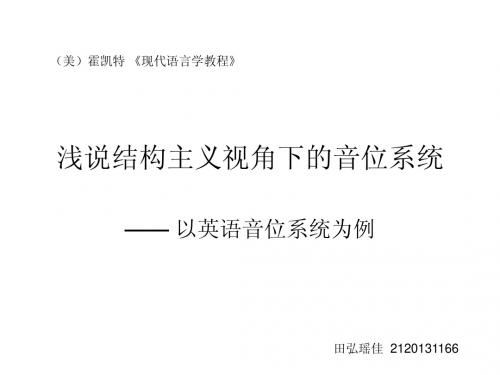
进一步举例:因语调不同而产生语义对立
It's ten o' clock I want to go home.
2It's 3ten
o' 2It's 3ten o' 2It's 3ten o' 2It's 3ten o'
│ 2I 3clock2 ↑2I 2clock2 ↑2I 3clock1 ↓2I
3clock2
(美)霍凯特 《现代语言学教程》
浅说结构主义视角下的音位系统
—— 以英语音位系统为例
田弘瑶佳 2120131166
在特定的情境里,一个人用不同的语言说不同的事情,声 音是不同的。因此想要了解语言是怎样运转的,我们必须研究 的一个课题就是语音——说话中使用的声音的种类,以及他们 是怎样产生的,怎样被察知的。语言学中的这一部分叫做音系 学或音位学。 在音位学的研究中必须始终记住的是,语音和语音之间的 差别在语言里只有一种功能:把话语区分开来。
下表中共列出了9群词,分别形成9个竖行,既列举出了英语词开首的不同单 辅音,又提供了这些辅音之间可能的全部双边对立的例子。每个横行为开首辅音 相同的词。可以看到有22个不同的辅音,共计231个双边对立,至此任何可能出 现的新情况基本已被穷尽了。
收尾辅音的整理方法与开首辅音基本相同,不过需要更多的词群才能 阐明全部的可能性。下表指出有21个不同的收尾辅音:
1.2.3 大音段
用一个语调说出来的一串话语材料叫做大音段。每个大音段的末尾都带有一 个终端调型,它自动标出一个话语里连续的的音段之间的界限。 - 3No1↓ - 3I want to go1↓ - 2I want to go 3there1↓ - 2What are we having for 3dinner1↓2beef2↑
现代语言学教程
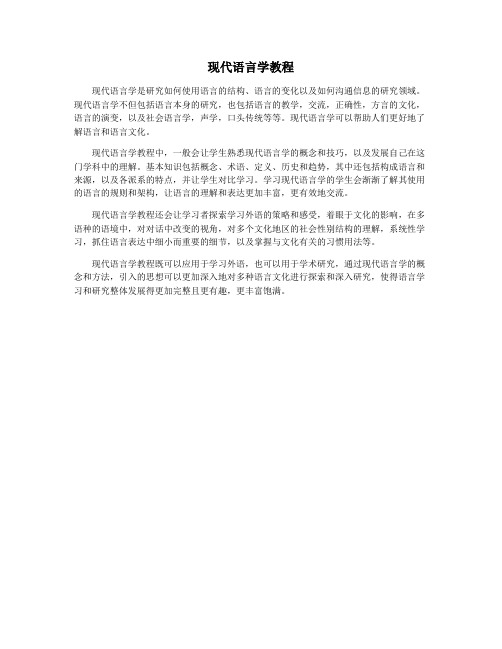
现代语言学教程
现代语言学是研究如何使用语言的结构、语言的变化以及如何沟通信息的研究领域。
现代语言学不但包括语言本身的研究,也包括语言的教学,交流,正确性,方言的文化,语言的演变,以及社会语言学,声学,口头传统等等。
现代语言学可以帮助人们更好地了解语言和语言文化。
现代语言学教程中,一般会让学生熟悉现代语言学的概念和技巧,以及发展自己在这门学科中的理解。
基本知识包括概念、术语、定义、历史和趋势,其中还包括构成语言和来源,以及各派系的特点,并让学生对比学习。
学习现代语言学的学生会渐渐了解其使用的语言的规则和架构,让语言的理解和表达更加丰富,更有效地交流。
现代语言学教程还会让学习者探索学习外语的策略和感受,着眼于文化的影响,在多语种的语境中,对对话中改变的视角,对多个文化地区的社会性别结构的理解,系统性学习,抓住语言表达中细小而重要的细节,以及掌握与文化有关的习惯用法等。
现代语言学教程既可以应用于学习外语,也可以用于学术研究,通过现代语言学的概念和方法,引入的思想可以更加深入地对多种语言文化进行探索和深入研究,使得语言学习和研究整体发展得更加完整且更有趣,更丰富饱满。
语言学教程[第十二章现代语言学理论与流派]山东大学期末考试知识点复习
![语言学教程[第十二章现代语言学理论与流派]山东大学期末考试知识点复习](https://img.taocdn.com/s3/m/27c8d95ca5e9856a57126077.png)
第十二章现代语言学理论与流派复习笔记I.索绪尔和现代语言学现代语言学始于瑞士语言学家索绪尔,他被称为“现代语言学之父”和一位“使语言学走向现代的大师”。
索绪尔认为,语言是用声音表达交流思想的符号系统。
符号是形式和意义的联合,是表示者和被表示者的结合。
符号是语言事实的核心,研究语言必须从符号本身的特性人手。
索绪尔区分了几组重要的概念:能指和所指,语言和言语,共时研究和历时研究等。
II.布拉格学派布拉格学派的形成可以追溯到马泰休斯领导召开的该学派的第一次会议。
1.主要观点及贡献布拉格学派的研究有三大重点:(1)强调共时研究的合理性,因为它可以提供完整且易掌控的研究材料。
(2)强调语言的系统性,指出任何语言单位都不能在孤立的的情况下得到令人满意的分析及评估。
换句话说,语言单位处于功能对比、对立之中。
(3)它将语言看作是在所属语言群体中发挥一系列功能的工具。
2.功能句子观功能句子观是一套语言学分析理论,它是指用信息论的原理来分析话语或文本。
其基本原则就是一句话中各部分起的作用取决于它对全句意义的贡献。
一些捷克语言学家尝试从功能的角度来分析句子。
他们相信一个句子包含话语的出发点和话语的目的。
话语的出发点叫做主位,它是说话人和听话人都知道的信息;话语的目的是说话人要向听话人传递的信息,叫做述位。
从主位到述位的运动揭示了大脑本身的运动。
功能句子观旨在研究话语中新(未知)、旧 (已知)信息的分布问题。
已知信息指那些对于听话人不再是新信息的部分;新信息是即将向听话人传达的信息。
句子中主语一谓语的分布不总是与主位一述位的分布一致。
3.交际能力另一种版本的分析法叫做交际能力,由费尔巴斯提出。
他用交际动力表示句子成分对交际发展所起的作用。
费尔巴斯把功能句子观解释为不同程度的交际力的分布。
他认为,句子前面部分承载的交际力最低,然后逐步增加,直到交际力最大的成分。
Ⅲ.伦敦学派1.介绍伦敦学派专门用来称呼独具英国特色的语言学研究。
现代语言学unit5 2015.10.17 4th

Behaviorism行为主义论 p93
given by Bloomfield 由 布鲁姆菲尔德提出;
the meaning of a language form is the “situation in which the speaker utters it and the response it calls forth in the hearer.”
3. Lexical meaning 词汇意义
word meaning: lexical 小节3 the meaning of language 语言意义 sentence meaning 小节4 句子意义 词汇意义
the sense of the word "dog"
refers to
the sameness or close similarity of meaning. Words that are close in meaning are called synonyms.
意义是指语言形式的内在意义。它是语言形式所有特 征的总和,它是抽象且脱离语境的。
简单地说,意义是词汇内在的,抽象的,游离于语境 之外的意义。
3.1 Sense and reference 意义和所指
2)
Reference means
what a linguistic form refers to in the real, physical world; (it deals with the relationship between the linguistic element and non-linguistic world of experience.)
现代语言学教程 整理笔记.
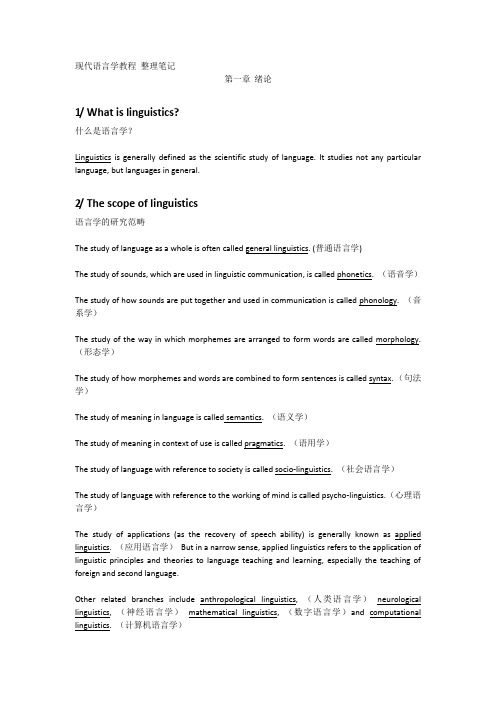
现代语言学教程整理笔记第一章绪论1/ What is linguistics?什么是语言学?Linguistics is generally defined as the scientific study of language. It studies not any particular language, but languages in general.2/ The scope of linguistics语言学的研究范畴The study of language as a whole is often called general linguistics. (普通语言学)The study of sounds, which are used in linguistic communication, is called phonetics. (语音学)The study of how sounds are put together and used in communication is called phonology. (音系学)The study of the way in which morphemes are arranged to form words are called morphology. (形态学)The study of how morphemes and words are combined to form sentences is called syntax. (句法学)The study of meaning in language is called semantics. (语义学)The study of meaning in context of use is called pragmatics. (语用学)The study of language with reference to society is called socio-linguistics. (社会语言学)The study of language with reference to the working of mind is called psycho-linguistics. (心理语言学)The study of applications (as the recovery of speech ability) is generally known as applied linguistics. (应用语言学)But in a narrow sense, applied linguistics refers to the application of linguistic principles and theories to language teaching and learning, especially the teaching of foreign and second language.Other related branches include anthropological linguistics, (人类语言学)neurological linguistics, (神经语言学)mathematical linguistics, (数字语言学)and computational linguistics. (计算机语言学)3/ Some important distinctions in linguistics语言学研究中的几对基本概念Prescriptive and descriptive 规定与描写If a linguistic study describes and analyzes the language people actually use, it is said to be descriptive, if it aims to lay down rules to tell people what they should say and what they should not say, it is said to be prescriptive.Modern linguistics differs from traditional grammar. Traditional grammar is prescriptive while modern linguistics is descriptive. The task of linguists is supposed to describe the language people actually use, whether it is “correct” or not.Synchronic and diachronic 共时和历时The description of a language at some point in time is a synchronic study; the description of a language as it changes through time is a diachronic study. In modern linguistics, synchronic study is more important.Speech and writing 口头语与书面语Speech and writing are the two major media of communication. Modern linguistics regards the spoken form of language as primary, but not the written form. Reasons are: 1. Speech precedes writing; 2. There are still many languages that have only the spoken form; 3. In terms of function, the spoken language is used for a wider range of purposes than the written, and carries a larger load of communication than the written.Langue and parole 语言和言语The Swiss linguist F. de Saussure made the distinction between langue and parole early 20th century.Langue refers to the abstract linguistic system shared by all the members of a speech community, and parole refers to the realization of langue in actual use. Saussure made the distinction in order to single out one aspect of language for serious study. He believes what linguists should do is to abstract langue from parole, to discover the regularities governing the actual use of language and make them the subjects of study of linguistics.Competence and performance 语言能力和语言运用Proposed by American linguist N. Chomsky in the late 1950’s.He defines competence as the ideal user’s knowledge of the rules of his language, and performance the actual realization of this knowledge in linguistic communication. He believes the task of the linguists is to discover and specify the language rules.4/ What is language?语言的定义Language is a system of arbitrary vocal symbols used for human communication.Sapir uses “ideas”“emotions” and “desires” in his definition. Hall, like Sapir, treats language as a purely human institution. Chomsky’s definition is quite different, it focus on the purely structural properties of languages and to suggest that these properties can be investigated from a mathematically precise point of view.5/ Design features语言的甄别性特征Design features refer to the defining properties of human language that distinguish it from any animal system of communication. American linguist Charles Hockett specified twelve design features, five of which will be discussed here.Arbitrariness 语言的随意性Arbitrariness means that there is no logical connection between meanings and sounds. It is not entirely arbitrary.Example: different sounds are used to refer to the same object in different languages. Productivity 语言的创造性Language is productive in that it makes possible the construction and interpretation of new signals by its users. This is why they can produce and understand an infinitely large number of sentences, including sentences they have never heard before.Duality 语言的二重性The duality nature of language means that language is a system, which consists of two sets of structure, or two levels, one of sounds and the other of meaning.Displacement 语言的移位性Displacement means that language can be used to refer to things which are present or not present, real or imagined matters in the past, present, or future, or in far-away places.Cultural transmission 语言的文化传递性While human capacity for language has a genetic basis, i.e., we were born with the ability to acquire language, the details of any language are not genetically transmitted, but instead have to be taught and learned anew. This indicates that language is culturally transmitted. It is passed down from one generation to the next through teaching and learning, rather than by instinct.Chapter 2 Phonology 音系学1.The phonic medium of language语言的声音媒介Speech and writing are the two media used by natural languages as vehicles for communication. Of the two media of language, speech is more basic than writing. Speech is prior to writing. The writing system of any language is always “invented” by its users to record speech when the need arises.For linguists, the study of sounds is of greater importance than that of writing.The limited ranges of sounds which are meaningful in human communication and are of interest to linguistic studies are the phonic medium of language (语言的声音媒介) . The individual sounds within this range are the speech sounds (语音). 2.What is phonetics?什么是语音学?Phonetics is defined as the study of the phonic medium of language;It is concerned with all the sounds that occur in the world’s languages.语音学研究的对象是语言的声音媒介,即人类语言中使用的全部语音。
现代语言学教程语法核心
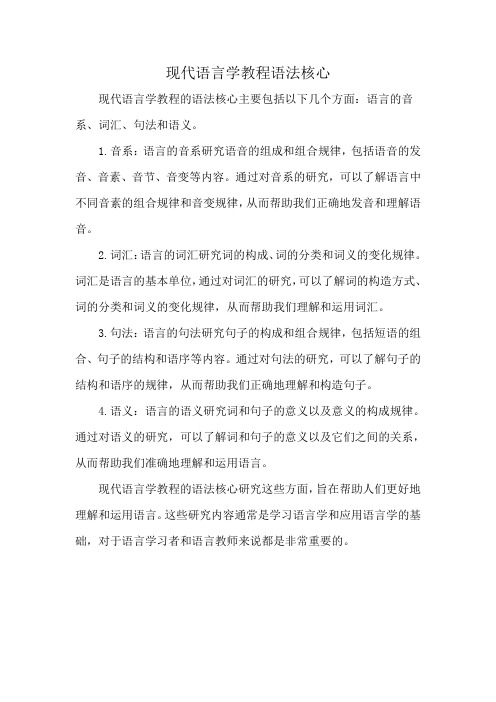
现代语言学教程语法核心
现代语言学教程的语法核心主要包括以下几个方面:语言的音系、词汇、句法和语义。
1.音系:语言的音系研究语音的组成和组合规律,包括语音的发音、音素、音节、音变等内容。
通过对音系的研究,可以了解语言中不同音素的组合规律和音变规律,从而帮助我们正确地发音和理解语音。
2.词汇:语言的词汇研究词的构成、词的分类和词义的变化规律。
词汇是语言的基本单位,通过对词汇的研究,可以了解词的构造方式、词的分类和词义的变化规律,从而帮助我们理解和运用词汇。
3.句法:语言的句法研究句子的构成和组合规律,包括短语的组合、句子的结构和语序等内容。
通过对句法的研究,可以了解句子的结构和语序的规律,从而帮助我们正确地理解和构造句子。
4.语义:语言的语义研究词和句子的意义以及意义的构成规律。
通过对语义的研究,可以了解词和句子的意义以及它们之间的关系,从而帮助我们准确地理解和运用语言。
现代语言学教程的语法核心研究这些方面,旨在帮助人们更好地理解和运用语言。
这些研究内容通常是学习语言学和应用语言学的基础,对于语言学习者和语言教师来说都是非常重要的。
现代语言学教程读后感悟3050字
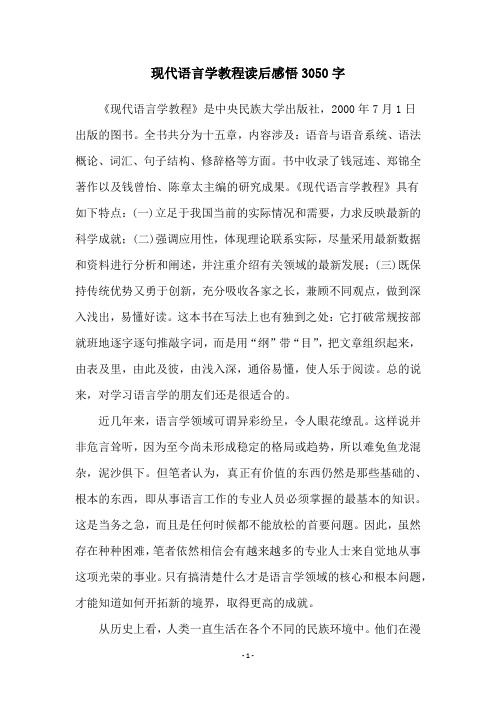
现代语言学教程读后感悟3050字《现代语言学教程》是中央民族大学出版社,2000年7月1日出版的图书。
全书共分为十五章,内容涉及:语音与语音系统、语法概论、词汇、句子结构、修辞格等方面。
书中收录了钱冠连、郑锦全著作以及钱曾怡、陈章太主编的研究成果。
《现代语言学教程》具有如下特点:(一)立足于我国当前的实际情况和需要,力求反映最新的科学成就;(二)强调应用性,体现理论联系实际,尽量采用最新数据和资料进行分析和阐述,并注重介绍有关领域的最新发展;(三)既保持传统优势又勇于创新,充分吸收各家之长,兼顾不同观点,做到深入浅出,易懂好读。
这本书在写法上也有独到之处:它打破常规按部就班地逐字逐句推敲字词,而是用“纲”带“目”,把文章组织起来,由表及里,由此及彼,由浅入深,通俗易懂,使人乐于阅读。
总的说来,对学习语言学的朋友们还是很适合的。
近几年来,语言学领域可谓异彩纷呈,令人眼花缭乱。
这样说并非危言耸听,因为至今尚未形成稳定的格局或趋势,所以难免鱼龙混杂,泥沙俱下。
但笔者认为,真正有价值的东西仍然是那些基础的、根本的东西,即从事语言工作的专业人员必须掌握的最基本的知识。
这是当务之急,而且是任何时候都不能放松的首要问题。
因此,虽然存在种种困难,笔者依然相信会有越来越多的专业人士来自觉地从事这项光荣的事业。
只有搞清楚什么才是语言学领域的核心和根本问题,才能知道如何开拓新的境界,取得更高的成就。
从历史上看,人类一直生活在各个不同的民族环境中。
他们在漫长的岁月中创造着丰富灿烂的物质文明和精神财富,包括语言、文化、风俗、思想、制度等。
在中华民族五千年的文明史中,无论是远古、中世纪还是近代,汉语始终占据着极其重要的位置。
一、什么叫“意义”呢?我们知道,从某一角度讲,语言是一种社会现象。
作为社会现象,它首先表达人们交流思想感情、描绘世间万象的意向。
但人们不仅仅满足于意向的表达,而是希望借助语言符号去再现或记载某种现实场景。
重温霍凯特的《现代语言学教程》
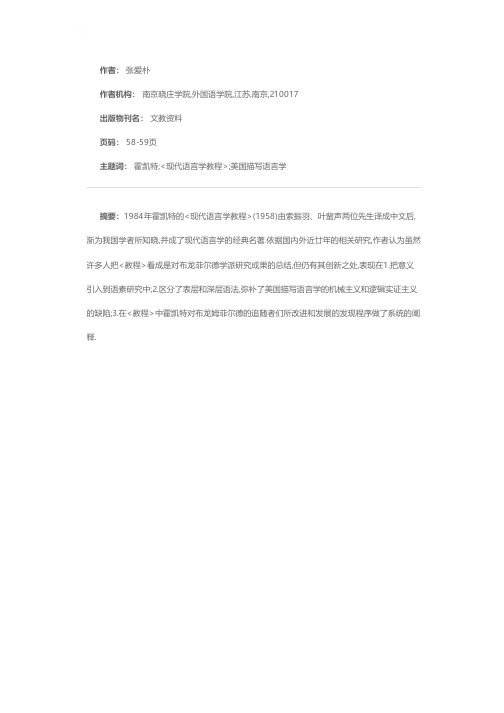
作者: 张爱朴
作者机构: 南京晓庄学院,外国语学院,江苏,南京,210017
出版物刊名: 文教资料
页码: 58-59页
主题词: 霍凯特;<现代语言学教程>;美国描写语言学
摘要:1984年霍凯特的<现代语言学教程>(1958)由索振羽、叶蜚声两位先生译成中文后,渐为我国学者所知晓,并成了现代语言学的经典名著.依据国内外近廿年的相关研究,作者认为虽然许多人把<教程>看成是对布龙菲尔德学派研究成果的总结,但仍有其创新之处,表现在1.把意义引入到语素研究中;2.区分了表层和深层语法,弥补了美国描写语言学的机械主义和逻辑实证主义的缺陷;3.在<教程>中霍凯特对布龙姆菲尔德的追随者们所改进和发展的发现程序做了系统的阐释.。
现代语言学教程读书报告

现代语言学教程读书报告索绪尔的《普通语言学教程》读书报告索绪尔是现代语言学的重要奠基者,也是结构主义的开创者之一。
他被后人称为现代语言学之父,结构主义的鼻祖。
《普通语言学教程》是索绪尔的代表性著作,集中体现了他的基本语言学思想,对二十世纪重要的哲学流派结构主义的重要思想来源。
这里,我概要的介绍一下索绪尔的生平和他的《普通语言学教程》。
索绪尔于1857年出生于瑞士日内瓦。
早在中学时期,索绪尔对语言学产生了浓厚的兴趣,14岁时就撰写过一篇《论语言现象》的论文,从20岁开始构思一部专著,研究印欧语历史比较中的某些问题。
1879年,他转学到柏林大学,同年发表了《论印欧系语言元音的原始系统》,那时,他才22岁,表现了他极为出色的语言学才华,引起欧洲语言学界的注意。
1891年冬,索绪尔离开巴黎,回到瑞士担任日内瓦大学教授,1907年开始讲授“普通语言学”课程,先后讲过三次。
1913年他去世后,他的学生和同事根据几本听课笔记才汇编成《普通语言学教程》一书,出版发行。
索绪尔不仅吝于发表,他留下的笔记也很少,因此编辑这本书很不容易。
因为,跟所有的老师一样,他讲课时也是有很多重复,甚至不一致的内容。
难得的是编辑者们没有放弃,合并梳理一本书,从而造就了一部惊世巨著,也正是这部著作开启了语言整体结构研究的新阶段。
《普通语言学教程》是索绪尔最重要的著作。
除绪论外,共分为5编。
“绪论”简单地叙述了语言学的历史,语言学的材料和任务,语言学和毗邻学科的关系,语言学的对象,语言的语言学和言语的语言学,语言的内部要素和外部要素,表现语言的文字,音位学以及附录音位学原理。
第一编“一般原则”部分主要讲语言符号的性质,符号的不变性和可变性,静态语言学和演化语言学。
第二编“共时语言学”部分讲语言的具体实体,同一性、现实性和价值,语言的价值,句段关系和联想关系,语言的机构,语法及其区分,抽象实体在语法中的作用。
第三编“历时语言学”部分讲语音变化,语音演化在语法上的后果,类比作用,类化和演变,流俗词源,粘合作用,历时的单位,同一性和现实性,以及附录:主观分析和客观分析,主观分析和次单位的确定,词源学。
现代语言学教程选读
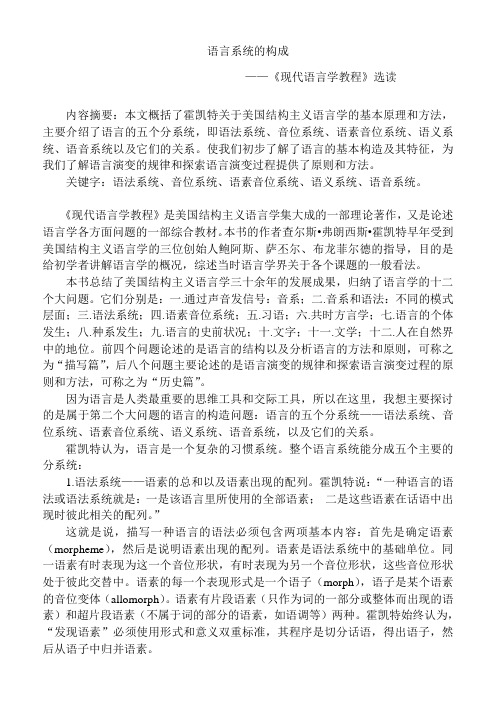
语言系统的构成——《现代语言学教程》选读内容摘要:本文概括了霍凯特关于美国结构主义语言学的基本原理和方法,主要介绍了语言的五个分系统,即语法系统、音位系统、语素音位系统、语义系统、语音系统以及它们的关系。
使我们初步了解了语言的基本构造及其特征,为我们了解语言演变的规律和探索语言演变过程提供了原则和方法。
关键字:语法系统、音位系统、语素音位系统、语义系统、语音系统。
《现代语言学教程》是美国结构主义语言学集大成的一部理论著作,又是论述语言学各方面问题的一部综合教材。
本书的作者查尔斯•弗朗西斯•霍凯特早年受到美国结构主义语言学的三位创始人鲍阿斯、萨丕尔、布龙菲尔德的指导,目的是给初学者讲解语言学的概况,综述当时语言学界关于各个课题的一般看法。
本书总结了美国结构主义语言学三十余年的发展成果,归纳了语言学的十二个大问题。
它们分别是:一.通过声音发信号:音系;二.音系和语法:不同的模式层面;三.语法系统;四.语素音位系统;五.习语;六.共时方言学;七.语言的个体发生;八.种系发生;九.语言的史前状况;十.文字;十一.文学;十二.人在自然界中的地位。
前四个问题论述的是语言的结构以及分析语言的方法和原则,可称之为“描写篇”,后八个问题主要论述的是语言演变的规律和探索语言演变过程的原则和方法,可称之为“历史篇”。
因为语言是人类最重要的思维工具和交际工具,所以在这里,我想主要探讨的是属于第二个大问题的语言的构造问题:语言的五个分系统——语法系统、音位系统、语素音位系统、语义系统、语音系统,以及它们的关系。
霍凯特认为,语言是一个复杂的习惯系统。
整个语言系统能分成五个主要的分系统:1.语法系统——语素的总和以及语素出现的配列。
霍凯特说:“一种语言的语法或语法系统就是:一是该语言里所使用的全部语素;二是这些语素在话语中出现时彼此相关的配列。
”这就是说,描写一种语言的语法必须包含两项基本内容:首先是确定语素(morpheme),然后是说明语素出现的配列。
现代语言学教学大纲
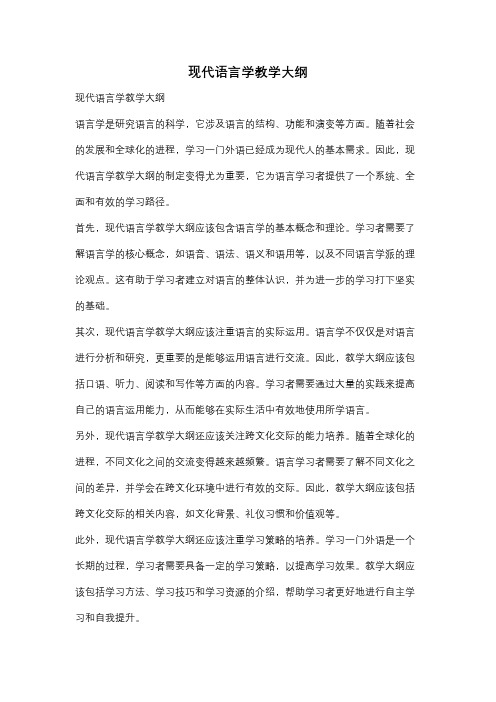
现代语言学教学大纲现代语言学教学大纲语言学是研究语言的科学,它涉及语言的结构、功能和演变等方面。
随着社会的发展和全球化的进程,学习一门外语已经成为现代人的基本需求。
因此,现代语言学教学大纲的制定变得尤为重要,它为语言学习者提供了一个系统、全面和有效的学习路径。
首先,现代语言学教学大纲应该包含语言学的基本概念和理论。
学习者需要了解语言学的核心概念,如语音、语法、语义和语用等,以及不同语言学派的理论观点。
这有助于学习者建立对语言的整体认识,并为进一步的学习打下坚实的基础。
其次,现代语言学教学大纲应该注重语言的实际运用。
语言学不仅仅是对语言进行分析和研究,更重要的是能够运用语言进行交流。
因此,教学大纲应该包括口语、听力、阅读和写作等方面的内容。
学习者需要通过大量的实践来提高自己的语言运用能力,从而能够在实际生活中有效地使用所学语言。
另外,现代语言学教学大纲还应该关注跨文化交际的能力培养。
随着全球化的进程,不同文化之间的交流变得越来越频繁。
语言学习者需要了解不同文化之间的差异,并学会在跨文化环境中进行有效的交际。
因此,教学大纲应该包括跨文化交际的相关内容,如文化背景、礼仪习惯和价值观等。
此外,现代语言学教学大纲还应该注重学习策略的培养。
学习一门外语是一个长期的过程,学习者需要具备一定的学习策略,以提高学习效果。
教学大纲应该包括学习方法、学习技巧和学习资源的介绍,帮助学习者更好地进行自主学习和自我提升。
最后,现代语言学教学大纲还应该注重评估和反馈。
学习者需要通过评估来检验自己的学习成果,并通过反馈来了解自己的不足之处。
教学大纲应该包括评估的标准和方法,以及提供及时的反馈和指导,帮助学习者不断提高自己的语言能力。
综上所述,现代语言学教学大纲应该全面、系统地介绍语言学的基本概念和理论,注重语言的实际运用,培养学习者的跨文化交际能力,培养学习策略,并提供评估和反馈。
这样的教学大纲能够为语言学习者提供一个科学、有效的学习路径,帮助他们更好地掌握所学语言,提高语言运用能力,从而更好地适应现代社会的需求。
- 1、下载文档前请自行甄别文档内容的完整性,平台不提供额外的编辑、内容补充、找答案等附加服务。
- 2、"仅部分预览"的文档,不可在线预览部分如存在完整性等问题,可反馈申请退款(可完整预览的文档不适用该条件!)。
- 3、如文档侵犯您的权益,请联系客服反馈,我们会尽快为您处理(人工客服工作时间:9:00-18:30)。
test volume to come out
4.can never go.
离心结构的特点是结构体的形类不同于
直接成分的形类。
离心结构可分为引导结构(包括介词结构、 连词结构、动宾结构)、系连结构和主谓 结构三大类。
引导结构和系练结构是短语形式 例如:on the table (介词结构)、saw john (动宾结构)
1.选择连接 2.上下文连接 如:black cat 1.she likes yellow clothes 和 strong soap will yellow clothes
3.标记连接 日语/anata no tomodati/(你的 朋友)有标记/no/ 4.在屈折语里,还有屈折连接
屈折连接包括:
英语:、A、V、NA、NV、AV、NAV七类, 凡不属于以上七类的是第八类——虚词
语法范畴:语法意义的大类。词形变化是语法
形式,每种词形变化都表示一定的语法意义,语 法范畴就是这些语法意义归纳出来的语法意义的 大类。分为选择范畴和屈折范畴两种。
语法范畴的类型:性、数、格、体、时、人称、 态等。
例如:太阳花在法语里是阳性,在德语里是阴性, 在俄语中是中性。
语素:语素是一种语言的话语里最小的独自有
意义的成分。语素是语法系统中的基础单位
语素配列:语素配列最基本的特点是层次性和递
归性。
例如:1.“这一个油桶大概在五分钟以内能流净”
2. “she bought a new hat (她买了一顶新帽子)和 he likes the old man (他喜欢这个老头)”
句法结构分为向心结构和离心结构。
向心结构:一个结构的形类至少与一个直
接成分的形类相似,即两者出现权的范围大 致重合。 例如:old dog 中old 是修饰语,dog是中心 语,men and women 中,men和women 向心结构有偏正结构(修饰型结构)和并列 结构(包括同位结构)
并列型向心结构就分类而言包括:1. 加合式,常常包含标记:and ; 2.选 择式,包含标记or; 3.其他的并列结 构;
例如:1.red and green
2.yesterday or today。
3.either john or bill 。
修饰型结构包括四种类型:1.修饰语在 前; 2.中心语在前; 3.修饰语是不连续的, 把中心语围在里面; 4.中心语是不连续的, 把修饰语围在里面;
例如:1.my dog 2.afraid of it the dark
(1)一致关系:muchacho bueno(孩子好=好孩子)
(2)支配的一致关系:梅诺米尼语的名词有数的
屈折
(3)支配关系:拉丁语短语ad eam partem(到那个
部分)
(4)互相参照:puer puellam amat(男孩女孩爱=
男孩爱女孩)
表层语法和深层语法
表层语法是显现于语言表面的语法, 最明显的、 可以直接观察到的层面构成表层语法。而深层 语法是对出现于语言实际运用中的语言形式所 作的内在分析,指的是潜在于句子内各成分或 形式的表层线性配列之下的语法和语义结构关 系。
句子是不跟其他任何语法形式处于 结构中的一种语法形式,即句子是 结构体而不是成分。
主谓结构的特点是说话人先说出一个 “话题”,再对“话题”作“说明”, 主谓结构体的“话题”通常是主语, “说明”通常是谓语,具有这种结构的 句子是常式句
处于结构中的句子或短语可以依靠一定方式互相 连接起来。包括以下方式:
《现代语言学教程》
语法系统浅析
语言是一个复杂的习惯系统,这种系统是有 结构的、分层面的。《现代语言学教程》把 语言分为三个中心分系统和两个外围分系统。
中心分系统:语法系统、音位系统、 语素音位系统 外围分系统:语义系统、语音系统
语法系统
每种语言都有自己的语法。霍凯特 说:“一种语言的语法或语法系统就 是:(1)该语言里所使用的全部语素。 (2)这些语素在话语中出现时彼此相 关的配列。”
语法核心是一种语言的语法要旨和不
同语言的语法系统之间的主要差别。 一种语言的语法核心包括:
(1)它的词类系统; (2)它的语法范畴; (3)它的功能成分; (4)它的结构类型和结构。
语法核心是一种语言的语法要旨和
不同语言的语法系统之间的主要差别。 霍凯特还改进了“直接成分分析法”, 不仅切分出语句的直接成分,还吸收 了传统语法的效果,标出直接成分的 结构关系。
语法系统:一种语言的语法系统由词法和
句法两个系统构成。
词是由较小的成分按一定模式构成,是句子中 以前后两个可能停顿为界的任何片段。词法包 括全部片段语素和由它们构成词的方法。词类 系统就是根据屈折上和句法上表现的异同对全 部词干做出分类。
分层划分词类:先根据词干在基本方面的
异同分出少数几个大类,然后根据附加的 标准层层分出小类 拉丁语系统的三分格局,包括:名词(广 义的)、动词、虚词
谢谢!
